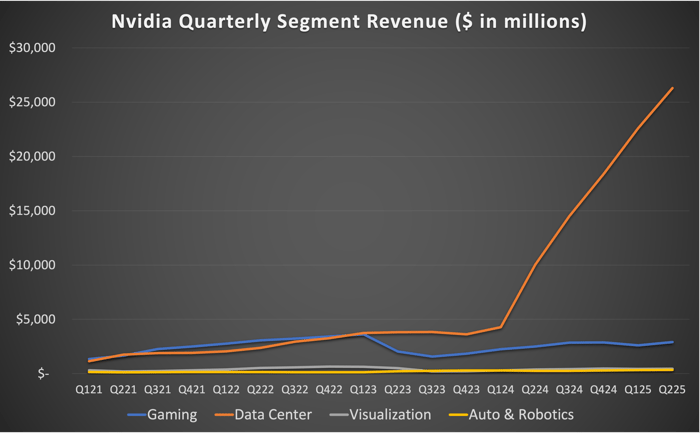This article was originally published on Fool.com. All figures quoted in US dollars unless otherwise stated.
It's natural for investors who don't own Nvidia (NASDAQ: NVDA) stock to think they've missed out. After all, the stock price has soared 243% in just the past year, and 543% over the last three years. But rather than looking back, let's look ahead and see if it has even more room to run.
Nvidia isn't just an artificial intelligence (AI) company. It has four business segments, and each one realised sequential quarterly revenue growth as well as year-over-year increases in the latest quarterly period. The data center segment that supports the growing need for advanced AI computer chips is growing the fastest, and there may be plenty more to come.

Data source: Nvidia. Chart by author.
Prediction: Another $1 trillion investment coming
Back in February Nvidia CEO Jensen Huang made this prediction: "There's about a trillion dollars' worth of installed base of data centers. Over the course of the next four or five years, we'll have $2 trillion worth of data centers that will be powering software around the world."
Nvidia already has a market cap of about $3.4 trillion. But if he's right, that's a significant amount of additional sales for the undisputed AI leader. And there's growing evidence that Huang's prediction is playing out.
Microsoft recently gave investors an idea of just how much its spending on data centers has exploded. In its latest 10-K annual report filed for fiscal year 2024 (ended in June), Microsoft noted that it had $108.4 billion in financial lease commitments for data centers that will commence over the next five years. That's almost $100 billion more than just two years ago, and these leases will run for up to 20 years.
Not many investors saw the explosive growth in AI data centers coming. There looks to be plenty of growth left for that segment, though, and it's a great reason to buy Nvidia stock now. And don't forget its other businesses like automotive and robotics that could follow as progress is made on self-driving cars and businesses seek more automation.
This article was originally published on Fool.com. All figures quoted in US dollars unless otherwise stated.









